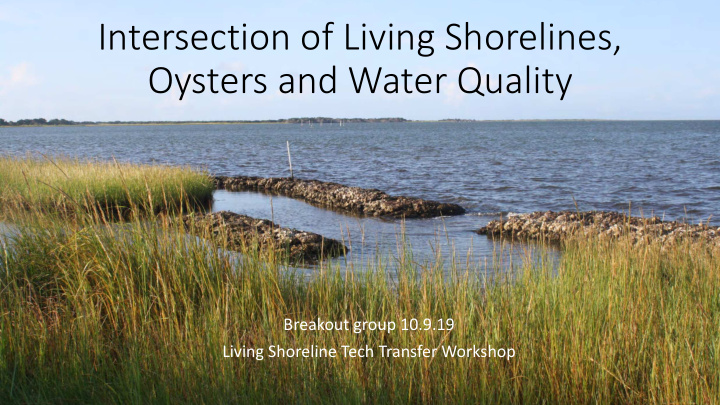



Intersection of Living Shorelines, Oysters and Water Quality Breakout group 10.9.19 Living Shoreline Tech Transfer Workshop
Living Shorelines Water Oysters Quality
Chesapeake Bay Louisiana North Carolina Your Experience Common Challenges
Experience Common Challenges Solutions
Hierarchy of Erosion Control Options No Action Relocation of Threatened Structures Non-Structural Stabilization Measures (Slope Grading, Marsh Creation, Bio-Engineering) Combination Approaches (Sills, Stone containment cells, breakwaters with plantings) Hardening Structures (Groins, Revetments, Bulkheads)
Functions and Values of a Living Shoreline o Shoreline Stabilization o Water Quality o Productivity o Habitat Enhancement
Value and Importance of Oysters o Improve Water Quality o Stabilize Shorelines o Provide Habitat o Important to Coastal Culture, Heritage and Economy
N.C. Oyster Restoration and Protection Plan: A Blueprint for Action Currently in the Third Edition
SANC NCTUARIES Larger scale oyster sanctuaries are constructed throughout North Carolina’s sounds. These sanctuaries are typically closed to harvest, but open to hook and line fishing. They are strategically located and designed to as a reliable oyster larvae seed source for the wild population and cultch planted areas.
To create reefs, the N.C. Division of Marine Fisheries (DMF) annually deposits tens of thousands of bushels of oyster shell, marine limestone and/or clam shell – called “cultch” – in shellfish waters. The cultch is colonized by oyster larvae that attach and grow to three- inch harvest size in 18-24 months. Cultch planting sites are open to public harvest once oysters reach legal harvest size (3 inches). CUL ULTCH P PLANT NTING NG
Oyster farming or mariculture has the potential to provide numerous benefits including increased water filtration and additional habitat for fish and other estuarine species. Oyster mariculture also has the potential to reduce harvest pressure off the native population while acting as an oyster larvae seed source to the surrounding waters. MARICULTU TURE
Water Q Quality Water ershed d res estoration pl plans a s are i e in n dev evel elopm pmen ent for or nearl rly a a dozen c coa oastal watersheds heds. W We work l k local ally t to craft ft an and implement t these p plans. T They f focu cus o on improving ng water er q qua uality by by r restoring ng h hydrology and w d wet etlands ds a and p d providi ding storm ormwater mana nagemen ent.
LIVING S NG SHORELINE NES AND P AND PATCH R REEF EFS These are typically smaller scale restoration efforts carried out by nonprofit organizations, universities or concerned community members. The reefs created are for shoreline protection and oyster habitat creation. They range in size from a tenth of an acre to two acres.
Recommend
More recommend